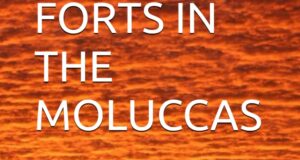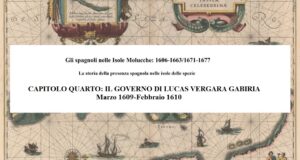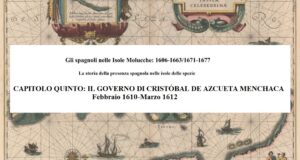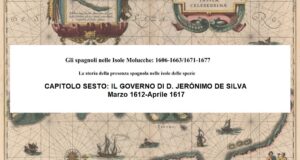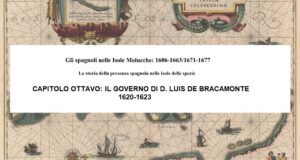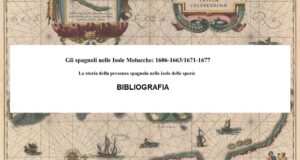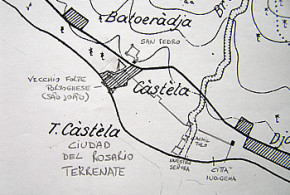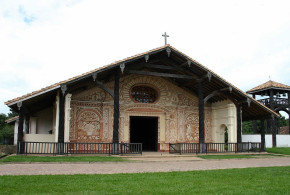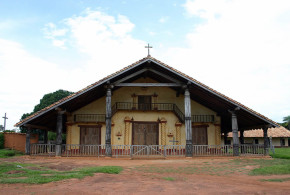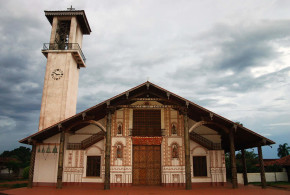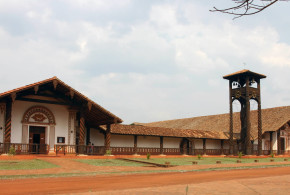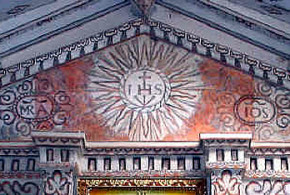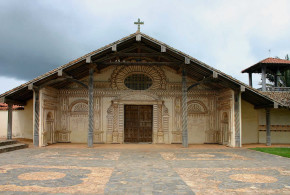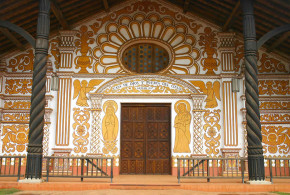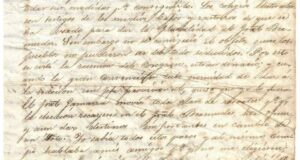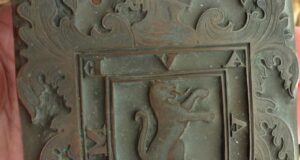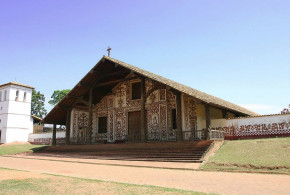This post is also available in:
![]() Italiano
Italiano
Written by Marco Ramerini 2000-2007/2023
6.5 – PULI CABALLO
Spanish: Puli Caballo: Sant Miguel de la isla de Puri Cauallo (Puli Cauallo)
(Current name: Pulau Mare)
CHRONOLOGY: Spanish: c.1650 ?-1662 ?
Dutch: Pottebackers Eyland
The island in question is a small island located south of Tidore, according to what de Clercq tells us, the name Mare meant ‘stone‘ both in Tidorese and in Ternatese, the island was renowned for its production of vases (hence derives the Dutch name of ‘Pottebacker Eyland‘), which were made with clay extracted from a hill located in the south-western part of the island. The only village on the island, called Mare, was located on the east coast.1 On the island of Puli Caballo, the Spanish maintained a fort during the last years of their presence. In some documents the name of the fort is also reported, which was that of ‘Sant Miguel de la isla de Puli Cauallo’.2
As for this fort, its foundation date is not certain, however, it is certain that in the years 1653 and 1654 Francisco de Estaybar rebuilt it.3 In 1654 the fort was garrisoned by 8 Spanish soldiers with a chief appointed by the governor of Ternate and 24 soldiers ‘pampangos’.4 During the period of the Tidorese rebellion (1657-1658), this fort had to endure several sieges.
In 1657 the fortress, under siege, by sea and land by the Dutch, Ternese and Tidorese rebels, was rescued with the galley ‘capitana’ by Sebastian de Villa Real (Villareal). Once the Spanish galley arrived in the vicinity of the island of Puli Cauallo, it was attacked by 18 boats of the rebels ‘mori‘ and 2 ‘charruas‘ of the Dutch, the Spaniards still managed to bring relief to the fort, disembarking a troop of infantry that was attacked by the enemies but they were routed and retreated, the Spaniards thus managed to free the fort from the siege.5 Sebastian de Villa Real with the ‘capitana‘ galley brought relief to the garrisons of Tidore and Puli Cauallo 4 times, during the period in which the ‘mori‘ had rebelled and had denied obedience to the king ‘cachil Mole‘, he rescued the garrisons of ‘Rrumen, Chouo, Tidore y Puri Cauallo’ with the galley with food and ammunition.
News of another siege of Puli Cauallo was reported in August 1658, when at a meeting of the ‘Junta‘ of Ternate (which took place on 12 August 1658) presided over by the governor Francisco de Esteybar, it was decided (with an order dated 13 August) to urgently send the ‘capitana‘ galley, which had been beached inside the barrier to careen it, and as many boats as possible loaded with soldiers, ammunition and artillery to help the fort of Puli Cauallo, because news had arrived that on Sunday 11 August had left from Malayo 10 ‘caracoas‘ and 2 enemy ‘charruas‘ with the aim of conquering the fort of Puli Cauallo.
Orders for the Villareals were to attack and destroy the enemy, doing all they could to relieve the fort. On this occasion the Spanish fleet consisted of the ‘capitana‘ galley and two ‘caracoras‘ and was led by sergeant major Felipe de Ugalde, while in command of the ‘capitana‘ galley was Sebastian de Villa Real (Villareal). The Spanish came within sight of the fort on August 15, 16586, when the enemy was assaulting the port with 2 ‘charraul‘ of 8 pieces each and 12 large ‘caracoas‘, the Spaniards managed to rout the ships and to make the enemies who had landed flee, freeing the fort from the siege.
It is interesting to note that in this document, a mention is made of the Spanish fort of ‘Santa Isauel‘ (probably a copyist’s mistake for: San Miguel ?) of the island of Puli Cauallo and its ‘rretirada‘ and ‘nuestra fuerza Santa Isauel y su rretirada en la ysla de Puli Cauallo‘. So this passage suggests the existence of two fortresses (as indeed in Rume and Chobo) whose names were perhaps ‘Santa Isabel‘ and ‘San Miguel‘. On another occasion, Villareal collided off Tidore with 12 ‘caracoas‘ escorted by a Dutch ship, which ‘salieron sobre Tomaloa a estoruarle‘ to prevent the arrival of help at the fort of ‘Puri Cauallo‘, despite the attack also this time the Spanish managed to relieve the fort.7
In 1662, when most of the Spanish forts on the island of Tidore were abandoned, the garrison of the Puli Cauallo fort was also withdrawn. According to the testimony of Diego de Salazar, captain of the royal galleys of Ternate, the fortresses that the Spaniards had to demolish and the garrisons they withdrew in 1662 were those of Tidore Chouo and Puli Cauallo ‘… me ordeno retirara las de Tidore Chouo, y Puli Cauallo …’.8
| Captains of San Miguel de la isla de Puli Cauallo | |
| Diego de (Vluiarri?)9 | ?-April/May 1662 |
INDEX:
1 – The Spanish fortresses on the island of Tidore 1521-1663: introduction
3 – The Spanish expeditions to the Moluccas after the union with Portugal
4 – The Spanish forts of the island of Tidore 1606-1663
5 – The defenses of the city of the King of Tidore: Lugar Grande De El Rey (Soa Siu)
6 – Fuerte de los portugueses (Fortaleza dos Reis Magos)
7 – Tohula Fort, Santiago de los Caballeros
8 – Sokanora Fort
9 – Marieco Fort
10 – Tomanira Fort
11 – Chobo Fort
12 – Fort of Rume
13 – Puli Caballo Island
14 – Captains of Tidore (Fortress of Santiago de los Caballeros)
NOTES:
1 De Clercq F.S.A. “Bijdragen tot de kennis der Residentie Ternate, 1890” (Leiden, 1890) 76-78
2 “Confirmación de encomienda de Tagui, etc. Expediente de confirmación de las encomiendas de Tugui (sic por Tagui)por otro nombre Masinloc, Sigayan, Ala Alan, Buquil, Bolinao y Agno en Pangasinan a Nicolás Jurado. Resuelto. [f] 28-04-1676” AGI: Filipinas,54,N.3
“Confirmación de encomienda de Abucay, etc. Expediente de confirmación de las encomiendas de Abucay y Samal en Pampanga a Diego Cortés. Resuelto. [f] 12-05-1676” AGI: Filipinas,54,N.9 foglio 93
3 “Confirmación de encomienda de Abucay, etc. Expediente de confirmación de las encomiendas de Abucay y Samal en Pampanga a Francisco de Esteybar. Resuelto. [f] 17-12-1661” AGI: Filipinas,51,N.14
4 “Confirmación de encomienda de Casiguran, etc. Expediente de confirmación de las encomiendas de Casiguran y Palanan en Tayabas a Pedro Lozano. Resuelto. [f] 02-05-1676” AGI: Filipinas,54,N.6
5 “Certification of the sergeant major don Sebastian de Villa Real” (Manila, 20 September 1673) (sheets 18-21) in: “Confirmación de encomienda de Majayjay, etc. Expediente de confirmacion de las encomiendas de Majayjay y Santa Cruz en La Laguna de Bay a Juan Rodríguez de Origuey. Resuelto[f]. 1695-06-08” AGI: Filipinas,58,N.3
6 In the document it is written 1659, but it is probably an error by the copyist for 1658, since all other testimonies always indicate the fact as having occurred in 1658.
7 “Confirmación de encomienda de Mambusao. Expediente de confirmación de la encomienda de Mambusao en Panay a Sebastián de Villarreal. Resuelto. [f] 19-05-1676” AGI: Filipinas,54,N.11
8 “Confirmación de encomienda de Majayjay, etc. Expediente de confirmacion de las encomiendas de Majayjay y Santa Cruz en La Laguna de Bay a Juan Rodríguez de Origuey. Resuelto[f]. 08-06-1695” AGI: Filipinas,58,N.3
Memorial of the ensign Juan de Origuey (Manila, 20 September 1673) (sheets 18-20) in: “Confirmación de encomienda de Batangas. Expediente de confirmación de la encomienda de Batangas en Balayan a Lorenzo de Zuleta. Resuelto. [f] 03-04-1677” AGI: Filipinas,54,N.14
9 In 1662, he was in charge of the fort of ‘San Miguel‘ of ‘Puli Cauallo‘, in April/May 1662 he was appointed head of the fort of Rume. “Confirmación de encomienda de Tagui, etc. Expediente de confirmación de las encomiendas de Tugui (sic por Tagui)por otro nombre Masinloc, Sigayan, Ala Alan, Buquil, Bolinao y Agno en Pangasinan a Nicolás Jurado. Resuelto. [f] 28-04-1676” AGI: Filipinas,54,N.3
This post is also available in:
![]() Italiano
Italiano
 Colonial Voyage The website dedicated to the Colonial History
Colonial Voyage The website dedicated to the Colonial History


